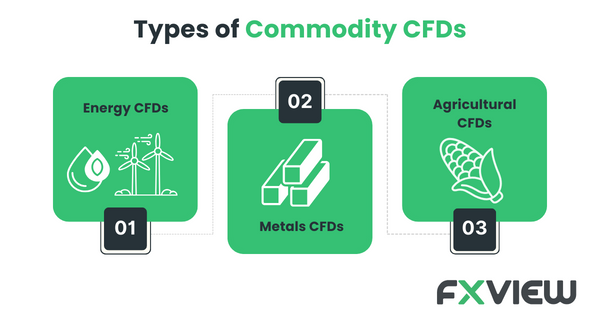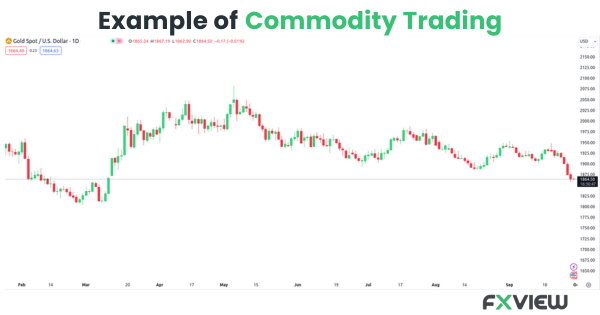
A Guide to Trade Commodity CFDs
For millennia, commodity trading has been a crucial component of the world economy. Since the introduction of commodity contracts for difference (CFDs), traders and investors have had more convenient and adaptable options to participate in trading in commodity CFDs. We’ll go into commodity trading in this guide and examine what commodities are, the different kinds of commodity CFDs that are available, how to trade them, and the main variables influencing commodity prices.
What are Commodities?
Commodities are tangible goods or raw materials that are interchangeable with other goods of the same type. They can be classified into two main categories:
- Hard Commodities: These encompass natural resources such as metals, energy products, and agricultural products. Here are some common hard commodities
- Soft Commodities: These include agricultural products that are grown rather than mined. Common soft commodities include Coffee, Cocoa, Cotton, and Orange Juice.
What are Commodity CFDs?
Financial derivatives called commodity contracts for difference (CFDs) let investors trade on changes in commodity prices without owning the underlying assets. The price differential between the commodity’s opening and closing positions is exchanged between the two parties in a CFD contract.

Types of Commodity CFDs in forex trading
Without owning the underlying physical assets, traders can speculate on the price changes of commodities using commodity CFDs. There are various types of commodity CFDs available, including:
- Oil CFDs: It encompasses various opportunities for traders to speculate on crude oil prices, encompassing both Brent Crude and West Texas Intermediate (WTI), two of the world’s most actively traded and impactful commodities.
- Precious Metals CFDs: These include gold, silver, platinum, and palladium. Gold and silver CFDs allow investors to profit from their price movements, while platinum and palladium CFDs enable speculation on these valuable metals’ prices, driven by diverse industrial applications.
- Base Metals CFDs: This exposes copper’s price, a vital industrial metal used in construction and manufacturing. These CFDs also track other critical base metals like aluminum, zinc, and nickel, essential in diverse industries.
- Exotic Commodity CFDs: In addition to mainstream commodities, some brokers may offer CFDs on exotic or less commonly traded commodities. These can include rare earth metals, lumber, rubber, and other unique commodities that may have specialized market dynamics and applications.
- Agricultural CFDs: Agricultural CFDs cover a range of commodities, including wheat, corn, soybeans, coffee, and cocoa. Trading in commodity CFDs enables traders and investors to engage in agricultural markets, speculating on price movements influenced.
- Energy CFDs: It offers investors opportunities to speculate on important energy sources. Natural Gas CFDs cover the natural gas market, used for heating, electricity, and industry. Heating Oil CFDs involve trading in heating oil, a key source for heating and power generation in different areas.
- Index CFDs: Certain brokerage platforms offer CFDs linked to commodity indices like the S&P GSCI Commodity Index. These indices represent a diversified basket of various commodities, granting investors a means to broaden and diversify their commodity investments efficiently.
- Exotic Commodity CFDs: Apart from mainstream commodities, select brokers may provide CFDs on exotic or less commonly traded commodities. These offerings can include rare earth metals, lumber, rubber, and other distinctive commodities characterized by specialized market dynamics and unique applications.

Here’s how trading in Commodity CFDs works
- Traders choose a commodity (e.g., Gold, Crude Oil) and decide whether they expect its price to rise (going long) or fall (going short).
- A CFD contract is entered into with a broker, specifying the opening and closing prices of the commodity.
- When the trader closes the CFD position, the difference in price between the opening and closing levels is settled in cash. If the price moves in the trader’s favour, they profit; if it moves against them, they incur a loss.
- Leverage, liquidity, and the opportunity to take advantage of both rising and falling markets are just a few benefits of using commodity CFDs.
How do you trade Commodity CFDs?
Trading in commodity CFDs involves several steps:
- Select a Reputable Broker: Choose a trusted CFD broker that offers a wide range of commodity CFDs, competitive spreads, and a user-friendly trading platform.
- Open a Trading Account: Sign up for an account with your chosen broker, complete the required documentation, and deposit funds into your trading account.
- Research and Analysis: Conduct thorough research on the commodities you intend to trade. Utilize both technical and fundamental analysis to have the possibility to make informed decisions.
- Place Orders: Use the broker’s trading platform to open positions.
- Implement Risk Management: Set stop-loss and take-profit orders to manage risk as part of your risk management strategy.
- Monitor and Adjust: Keep a close eye on your positions, monitor market news, and adjust your strategy as needed.
Factors affecting trading in Commodity CFDs
Several factors affect commodity pricing, including:
- Supply and demand: Production rate modifications, consumption habits, and worldwide demand can significantly affect commodity prices.
- Geopolitical Events: Supply chains can be disrupted and prices can be impacted by political unrest, trade disputes, and conflicts in important commodity-producing regions.
- Economic Indicators: The demand for commodities can be affected by economic data such as GDP growth, manufacturing production, and employment statistics.
- Currency Movements: Since commodity prices are frequently expressed in U.S. dollars, changes in exchange rates may have an impact on their costs.
- Natural Impacts: Natural catastrophes and meteorological conditions can have an impact on the availability of agricultural commodities.
- Government policies: Tariffs, subsidies, and restrictions all may have an impact on trading in commodity CFDs.
Is trading in Commodity CFDs right for you?
To determine if CFD (Contract for Difference) trading in commodities is suitable for you, you may consider these factors:
- Risk Tolerance: Assess your comfort with the potential for significant gains or losses due to leverage.
- Knowledge and Experience: Understand commodity market dynamics, including supply and demand factors, geopolitics, and economic indicators.
- Capital: Define your investment amount and establish a clear trading plan with risk management strategies.
- Time Commitment: Determine if you can commit the necessary time for active monitoring of the markets.
- Regulatory Environment: Be aware of local regulations and any restrictions on CFD trading.
- Costs and Fees: Understand the associated costs, such as spreads, overnight charges, and platform or broker fees.
- Investment Goals: Align your trading strategy with your financial objectives, whether short-term or long-term.
- Emotional Discipline: Get ready to control your emotions when trading, including how to deal with setbacks and refrain from making snap judgments.
- Education and Research: To stay informed about market movements, and trading tactics and consider constant learning.
- Diversification: Diversify your capital in various financial instruments; this can help you to manage your risk exposure.
- Technical Analysis: Traders rely on technical analysis, studying historical data like price charts and volumes, and using indicators to spot entry and exit points for short-term trading decisions.
- Interest Rates: Central bank interest rates can affect financing costs, potentially increasing expenses for storing and financing commodities, thereby influencing supply and demand dynamics of trading in commodity CFDs.
- Liquidity and Market Participants: Market liquidity and the mix of participants, including hedgers, speculators, and institutional investors, impact trading strategies and risk management, ultimately shaping the dynamics of commodity markets.
- Black Swan Events: Unpredictable “Black Swan” events, such as natural disasters or global crises, have the potential to disrupt commodity markets without warning, emphasizing the importance of being prepared and adaptable.
Before trading in commodity CFDs, do your homework, talk to a financial advisor, start small, or utilize a demo account to match your objectives, risk tolerance, and level of experience.
Key Takeaways
- Overview of Commodities: Hard (metals, energy, agriculture) and soft (agricultural) commodities are tangible things or raw materials.
- Varieties of Commodity CFDs: Trading in commodity CFDs comes in three primary varieties: futures, spot, and index CFDs, each of which has unique advantages and trading methods.
- Commodity CFDs: An explanation of commodities contracts for difference (CFDs), which let traders speculate on changes in commodity prices without owning the underlying assets.
- Trading Procedures: Choosing a trustworthy broker, doing research and analysis, placing orders based on market expectations, and applying risk management are all part of trading in commodity CFDs.
- Factors Impacting Commodity Prices: Commodity prices are impacted by several variables, including supply and demand, geopolitical events, economic indicators, currency fluctuations, climatic circumstances, and governmental regulations.
- Trader Considerations: Traders should assess risk tolerance, gain market experience, allocate capital wisely, monitor markets, adhere to regulations, manage costs, set goals, stay emotionally disciplined, focus on education, and consider diversification.
Conclusion
Trading in commodity CFDs offers a flexible and accessible way to participate in the commodity markets, which have been a cornerstone of the global economy for centuries. However, trading these derivatives requires careful consideration of various factors and a well-defined trading strategy in the forex market. Whether you’re an experienced trader or new to the world of commodities, thorough research and a commitment to continuous learning are essential for making informed decisions and managing the high risks associated with trading in commodity CFDs.
Disclaimer: The information in this article is provided for educational and informational purposes only and is not intended to be, nor does it constitute financial, investment or trading advice. You should not make any financial, investment or trading decision based on the information provided in this article without performing your own research or seeking advice from an independent advisor.
